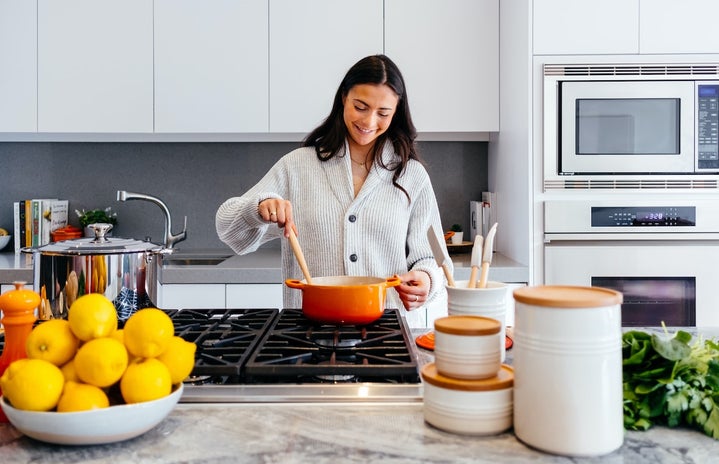Having to cook as a college student can be challenging when you are not a professional chef like Gordon Ramsay. As a busy college student, I am constantly running to and from class and by the end of the day, I am too emotionally and physically drained to cook dinner. Don’t turn to takeout meals which can be unhealthy and costly. Cooking for one can be an inconvenience and challenging for anyone, especially when in college, but I’m here to make things easier for you. Here are some tips and tricks to make delicious, easy meals that are perfect for a woman in college.
1. Have the basics on hand!
Be sure to keep staple ingredients in your pantry. Having a well-stocked pantry filled with the basics is essential. You are more inclined to make a delicious, healthy meal when you already have the ingredients on hand. Consider making a checklist of some necessary items that are easy to have on hand and very versatile. Buying non-perishable items in bulk to keep in your cabinets is an easy way to save money and allows for you to make a variety of dishes. Some of these ingredients might include:
Grains like pasta, rice and couscous
Nuts and seeds
Chicken or Vegetable
Sugar
Tomato paste
Salsa
Canned Beans
Flour
Olive oil
Vinegar (any kind)
Tomato sauce
2. Invest in quality dried herbs and spices
Having good seasonings will enhance your dish and take it to a whole new level! Putting your favorite spices into a dish contributes rich flavor and makes it more unique. Cooking with different spices adds aromas and a range of flavors. Not only do spices enhance the taste in meals, but they can also make them look more appealing by adding some color. Different cultures use a wide variety of flavors in their cuisines which make them so unique. Here are some must-have seasonings to keep on your spice rack:
Paprika
Garlic Powder
Kosher Salt
Dried Rosemary
Black Peppercorns
Dried Oregano
Red Pepper Flakes
Chili Powder
Cinnamon
Dried Parsley
Dried Thyme
Nutmeg
Curry Powder
Allspice
Cayenne Pepper
3. Ensure not to purchase too much fresh produce
Fresh produce can be difficult to buy on a budget and for just one person. One way to save some cash is by purchasing fresh produce that is in season. It is also important to plan your meals for the week and only purchase the amount of produce you think you will be using. I wash, dry and bag up my produce as soon as I get home from the grocery store. This will help with quick meal preparation when you are short on time and will also keep you on track for healthy eating. To keep produce fresh longer place clean produce in a freezer bag with a dry paper towel. Berries keep well sealed in a mason jar. There are many fruits and vegetables that last longer than others if stored in the proper conditions. Some of the fruits and veggies with the longest shelf life include:
Potatoes (2-6 months)
Squash (1-3 months)
Citrus fruits (1-2 months)
Carrots (3-4 weeks)
Apples (1-2 months)
Celery (2-3 weeks)
Onions (2 months)
Garlic (up to 6 months)
4. Get creative with leftovers!
If you find yourself making too much, you can repurpose your leftovers by adding some new spices or adding a few more simple ingredients to it. Leftover stir fry can be used in an omelet and leftover chicken can be used for fajitas.
You can also freeze your leftovers for another time. Start by dividing up your cooled leftovers. Plastic or glass containers are best for storing leftovers. However, it’s extremely important that you leave a little bit of room in your containers, as the food will swell once frozen. Another great way to store leftovers is in resealable bags. One way you can make your leftovers last longer is by applying a layer of plastic wrap to prevent freezer burn. I recommend writing the date you are freezing on top of the container. It is recommended to eat frozen leftovers within 2-6 months because the quality can depreciate.
Here is a favorite meal of mine that is quick, easy and healthy:
Start by sautéing a tablespoon of garlic and half of a chopped onion in olive oil for 2-3 mins. Add in a can of tomato sauce and a can of diced tomatoes. Season with salt, pepper and basil to taste and simmer for 10-15 minutes. While the sauce is simmering, boil your favorite pasta. Serve with a tossed salad and top the pasta with Romano or Parmesan. I promise this homemade sauce is more flavorful and healthier than canned or jarred sauce.


